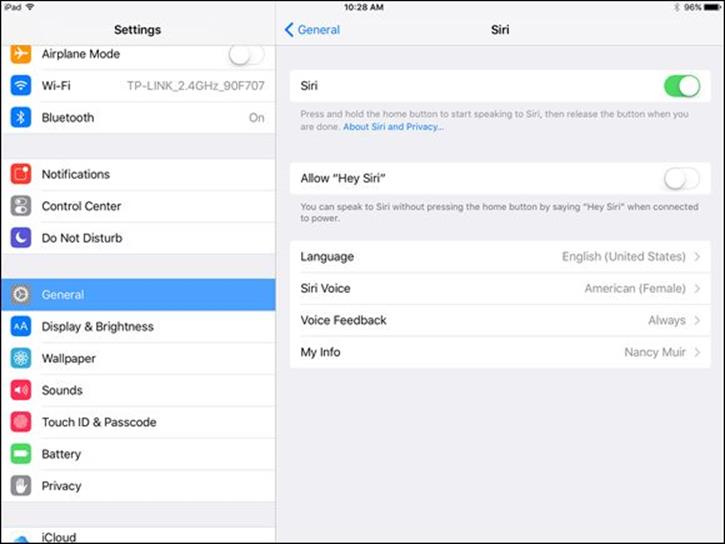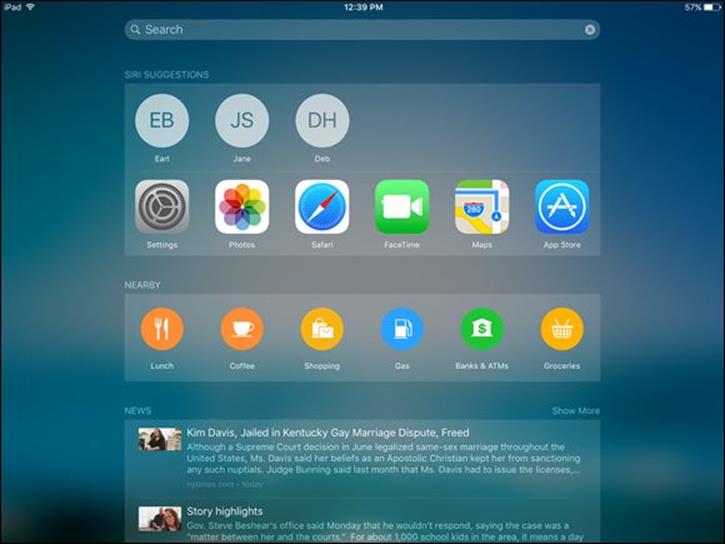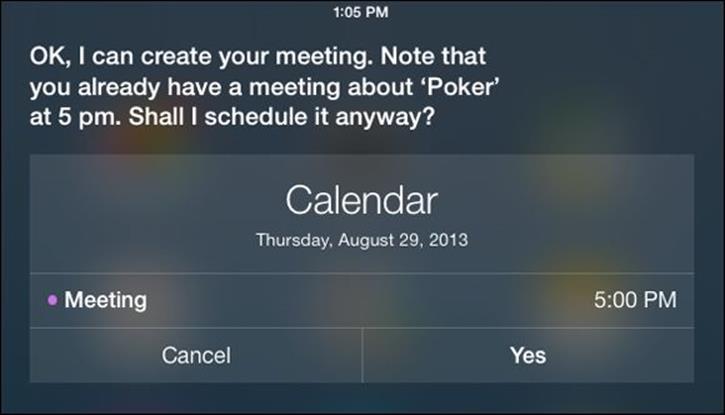iPad For Seniors For Dummies, 8th Edition (2016)
Part IV. Managing Your Life and Your iPad
Chapter 19. Talking to Your iPad with Siri
Get ready to …
· Activate Siri
· Understand All That Siri Can Do
· Get Suggestions
· Call Contacts via FaceTime
· Create Reminders and Alerts
· Add Tasks to Your Calendar
· Play and Identify Music
· Get Directions
· Ask for Facts
· Search the Web
· Send Email, Tweets, or Messages
· Get Helpful Tips
One of the coolest features in iPad is Siri, a personal-assistant feature that responds to spoken commands. With Siri on your iPad, you can ask for nearby restaurants, and a list appears. You can open apps with a voice command and ask Siri to open the App Store. You can dictate your email messages rather than type them. Placing a FaceTime call to your mother is as simple as saying “Call Mom.” Want to know the capital of Rhode Island? Just ask. Siri checks several online sources to answer questions ranging from the result of a mathematical calculation to the size of Jupiter. With iOS 9, Siri searches more broadly, more quickly, and returns more results.
You can also have Siri perform tasks such as returning calls and controlling iTunes Radio. You can even play music and have Siri identify songs for you.
With iOS 9, Siri has gained some other improvements. For example, you can have Siri search photos and videos and locate what you need by date, location, or album name. You can also ask Siri to remind you about an app you’re working in, such as Safari, Mail, or Notes, at a later time so you can pick up where you left off.
Activate Siri
Siri is a very useful feature for interacting with your iPad and getting information. You can use Siri to ask for a map to a nearby restaurant, send an email, or tell you how far the Earth is from Pluto, for example. Siri will respond with an answer, display a map, or access web resources for you; see Figure 19-1.

Figure 19-1
Siri should be active when you get your iPad, but if for some reason it’s been deactivated, you can use Settings to turn Siri on by following these steps:
1. Tap the Settings icon on the Home screen.
2. Tap General to display the General settings (see Figure 19-2) and then tap Siri.
3. In the screen that appears (see Figure 19-3), tap the On/Off switch to turn Siri on.
4. If you want to change the language Siri uses, tap Language and choose a different language from the list that appears.
5. To change the nationality or gender of Siri’s voice from female to male or American to British or Australian, tap Siri Voice and then make your selections.

Figure 19-2

Figure 19-3
 If you buy a car with the new Car Play feature, you can interact with your car using your voice and Siri. These cars are just now being manufactured, so stay tuned to Apple.com for news about how they’ll work.
If you buy a car with the new Car Play feature, you can interact with your car using your voice and Siri. These cars are just now being manufactured, so stay tuned to Apple.com for news about how they’ll work.
 If you want Siri to respond to your verbal requests only when the iPad isn’t in your hands, tap Voice Feedback and choose Hands-Free Only. Here’s how this setting works and why you may want to use it: In general, if you’re holding your iPad, you can read responses on the screen, so you may not want to have your tablet talk to you. But if you’re puttering with, say, an electronics project, you may want to speak requests for mathematical calculations and hear the answers rather than having to read them. In such a situation, Hands-Free Only is a useful setting.
If you want Siri to respond to your verbal requests only when the iPad isn’t in your hands, tap Voice Feedback and choose Hands-Free Only. Here’s how this setting works and why you may want to use it: In general, if you’re holding your iPad, you can read responses on the screen, so you may not want to have your tablet talk to you. But if you’re puttering with, say, an electronics project, you may want to speak requests for mathematical calculations and hear the answers rather than having to read them. In such a situation, Hands-Free Only is a useful setting.
 Siri is available on the iPad only when you have Internet access, but remember that cellular data charges may apply when Siri checks online sources if that Internet connection is via 3G/4G. In addition, Apple warns that available features may vary by area.
Siri is available on the iPad only when you have Internet access, but remember that cellular data charges may apply when Siri checks online sources if that Internet connection is via 3G/4G. In addition, Apple warns that available features may vary by area.
Understand All That Siri Can Do
Siri allows you to interact with many apps on your iPad by voice. You can pose questions or ask to do something like make a FaceTime call or add an appointment to your calendar, for example. Siri can also search the Internet or use an informational database called Wolfram|Alpha to provide information on just about any topic. You don’t have to be in an app to make a request involving that app.
Siri also checks Wikipedia, Bing, and Twitter to get you the information you ask for. In addition, you can use Siri to tell the iPad to work with more features, such as opening and searching the App Store and controlling iTunes Radio playback.
Siri is the technology behind the iPad’s Dictation feature. When you have the onscreen keyboard open, note that it contains a microphone key that you can tap to begin or end dictation. This feature works in any app that uses the onscreen keyboard.
Siri requires no preset structure for your questions; you can phrase things in several ways. You might ask, “Where am I?” to see a map of your current location, or you could ask “What is my current location?” or “What address is this?” and get the same results.
If you ask a question about, say, the weather, Siri responds to you verbally; with text information; in a form, as with email (see Figure 19-4); or by opening a graphic display for some items, such as maps. When a result appears, you can tap it to make a choice or open a related app.

Figure 19-4
Siri knows what app you’re using, though you don’t have to have that app open to make a request involving it. However, if you are in the Messages app, you can make a statement like “Tell Susan I’ll be late,” and Siri knows that you want to send a message. You can also ask Siri to remind you about what you’re working on and Siri notes what you’re working on, in which app, and reminds you about it at a time you specify.
Siri works with FaceTime, the App Store, Music, Messages, Reminders, Calendar, Maps, Mail, Clock, Contacts, Notes, and Safari, as well as with several third-party apps. In the following tasks, I provide a quick guide to some of the most useful ways you can use Siri.
Note that no matter what kind of action you want to perform, first press and hold the Home button until Siri opens (see Figure 19-5). The rest of this chapter assumes that you’re working with an iPad running iOS 9.

Figure 19-5
You can activate Siri hands-free. With your iPad plugged into an outlet, car, or computer, just say “Hey Siri” and Siri opens up ready for a command. In addition, with streaming voice recognition, Siri displays in text what she’s hearing as you speak, so you can verify she’s understood you instantly. This streaming feature makes the whole process of interacting with Siri faster.
 Siri supports more than 30 languages, so you can finally show off those language lessons you took in high school.
Siri supports more than 30 languages, so you can finally show off those language lessons you took in high school.
Get Suggestions
 With iOS 9, your iPad anticipates your needs by making suggestions when you swipe from left to right on the initial Home screen. You’ll see a list of contacts you’ve communicated with recently, apps you’ve used, and nearby businesses such as restaurants, gas stations, or coffee spots (see Figure 19-6). If you tap on an app in the suggestions, it will open displaying the last viewed or listened to item.
With iOS 9, your iPad anticipates your needs by making suggestions when you swipe from left to right on the initial Home screen. You’ll see a list of contacts you’ve communicated with recently, apps you’ve used, and nearby businesses such as restaurants, gas stations, or coffee spots (see Figure 19-6). If you tap on an app in the suggestions, it will open displaying the last viewed or listened to item.

Figure 19-6
In addition, you’ll see news stories that may be of interest to you based on items you’ve viewed before.
Call Contacts via FaceTime
1. Make sure that the people you want to call are entered in your Contacts app and that you’ve included their phone numbers in their records. If you want to call somebody by stating your relationship to her, such as “Call sister,” be sure to enter that relationship in the Related field of her contact record, and make sure that the settings for Siri (refer to Figure 19-3) include your contact name in the My Info field. (See Chapter 18 for more about creating contact records.)
2. Press and hold the Home button until Siri appears.
3. Speak a command such as “Make a FaceTime call to Earl” or “FaceTime Mom.” Siri initiates the call. If you have two contacts who might match a spoken name, Siri responds with a list of possible matches. Tap one in the list or state the correct contact’s name to proceed.
4. To end the call before it completes, you can press the Home button and then tap End.
 To cancel any spoken request, you have four options: Say “Cancel,” tap the Dictation key on the Siri screen, press the Home button, or tap anywhere on the screen outside the Siri panel.
To cancel any spoken request, you have four options: Say “Cancel,” tap the Dictation key on the Siri screen, press the Home button, or tap anywhere on the screen outside the Siri panel.
Create Reminders and Alerts
1. You can also use Siri with the Reminders app. To create a reminder, press and hold the Home button and then speak a command, such as “Remind me about dentist appointment on Thursday at 12 p.m.” A preview of the reminder is displayed (see Figure 19-7).
2. Tap or say, “Remove” if you change your mind.
3. If you want a reminder ahead of the event you created, activate Siri and speak a command such as “Remind me tonight about the play on Thursday at 8 p.m.” Siri creates a second reminder, which you can confirm or cancel if you change your mind.

Figure 19-7
Add Tasks to Your Calendar
1. You can also set up events on your Calendar by using Siri. Press and hold the Home button and then speak a phrase such as “Set up meeting at 5 p.m. on July 23rd.” A sample calendar entry appears. Tap the Confirm button to save it.
2. If there’s a conflict, Siri tells you there’s already an appointment at that time (see Figure 19-8) and asks whether you still want to set up the new appointment. You can say, “Yes” or “Cancel” at that point or tap the Yes or Cancel button.

Figure 19-8
Play and Identify Music
1. You can use Siri to play music from the Music app and iTunes Radio. Press and hold the Home button until Siri appears.
2. To play music, speak a command, such as “Play music” or “Play ‘As Time Goes By’” to play a specific song or album.
3. When music is playing, use commands such as “Pause music,” “Next track,” and “Stop music” to control playback.
4. To identify music that’s playing, simply activate Siri and say something like “What song is playing?” Siri tells you and may even make the item available for purchase through iTunes.
 One of the beauties of Siri is that you don’t have to follow a specific command format, as you do with some other voice-command apps. You could say “Play the next track,” “Next track,” or “Jump to the next track on this album,” and Siri will get your meaning.
One of the beauties of Siri is that you don’t have to follow a specific command format, as you do with some other voice-command apps. You could say “Play the next track,” “Next track,” or “Jump to the next track on this album,” and Siri will get your meaning.
 If you’re listening to music or a podcast with earphones plugged in, and stop midstream, the next time you plug in earphones, Siri recognizes that you might want to continue with the same item.
If you’re listening to music or a podcast with earphones plugged in, and stop midstream, the next time you plug in earphones, Siri recognizes that you might want to continue with the same item.
Get Directions
You can use the Maps app and Siri to find your current location, get directions, find nearby businesses (such as restaurants or banks), or get a map of another location. Be sure to turn on Location Services to allow Siri to know your current location (tap Settings ⇒ Privacy ⇒ Location Services, and make sure the Location Services switch is set to on and that Siri & Dictation is turned on farther down in that same pane).
Here are some of the commands you can try to get directions or a list of nearby businesses:
· “Where am I?”
Siri displays a map of your current location. If you have a Wi-Fi–only iPad, this location may be approximate.
· “Where is Apache Junction, Arizona?”
Siri displays a map of that city.
· “Find restaurants.”
Siri displays a list of restaurants near your current location, as in Figure 19-9; tap one to display a map of its location.
· “Find a nearby bank.”
Siri displays a map indicating the location of that business (or, in some cases, several nearby locations, such as a bank branch and all ATMs).
· Get directions to the Empire State Building.
Loads a map with a route drawn and provides a narration of directions to the site from your current location.

Figure 19-9
 After a location is displayed in a map, tap the Information button on the location’s label to view its address, phone number, and website address, if available.
After a location is displayed in a map, tap the Information button on the location’s label to view its address, phone number, and website address, if available.
Ask for Facts
Wolfram|Alpha is a self-professed online computational knowledge engine, which means that it’s more than a search engine because it provides specific information about a search term rather than multiple search results. If you want facts without having to spend time browsing websites to find those facts, Wolfram|Alpha is a very good resource.
Siri uses Wolfram|Alpha and sources such as Wikipedia and Bing to look up facts in response to questions, such as “What is the capital of Kansas?”, “What is the square root of 2003?”, and “How large is Mars?” Just press and hold the Home button, and ask your question; Siri consults its resources and returns a set of relevant facts.
You can also get information about many things, such as the weather, stocks, or the time. Just say a phrase like one of these to get what you need:
· “What is the weather?”
Siri shows the weather report for your current location. If you want weather in another location, just specify the location in your question.
· “What is the price of Apple stock?”
Siri tells you the current price of the stock or the price of the stock when the stock market last closed. (Let’s hope that you own some.)
· “What time is it?”
Siri tells you the time in your time zone and displays a clock (see Figure 19-10).

Figure 19-10
Search the Web
Siri can use various resources to respond to specific requests, such as “Who is the Queen of England?”, but it searches the web if you ask more general requests for information. Siri can also search Twitter for comments related to your search.
If you speak a phrase such as “Find a website about birds” or “Find information about the World Series,” Siri can respond in a couple of ways. The app can simply display a list of search results by using the default search engine specified in your settings for Safari, or it can say “If you like, I can search the web for such-and-such.” In the first instance, just tap a result to go to that website. In the second instance, you can confirm that you want to search the web or cancel.
Send Email, Tweets, or Messages
You can create an email or an instant message with Siri and existing contacts. If you say “Email Jack Wilkes,” a form already addressed to that contact opens. Siri asks you what the subject is and what to say in the message. Speak your message and then say, “Send” to speed your message on its way.
Siri also works with the iMessage feature. Tap Siri and say “Message Sarah.” Siri creates a message and asks what you want to say. Say “Tell Sarah I’ll call soon,” and Siri creates a message for you to approve and send.
 It’s hard to stump Siri. Siri can’t tweet unless you’ve downloaded and set up the Twitter or Facebook app, for example. But if you speak a tweet without having Twitter installed, she gives you a link to tap to install the app! After you install these apps, you can say things to Siri such as “Post tweet” or “Post to Facebook” and Siri asks what you want to say, lets you review it, and posts it. Siri can also connect you with Flickr and Vimeo with those apps installed.
It’s hard to stump Siri. Siri can’t tweet unless you’ve downloaded and set up the Twitter or Facebook app, for example. But if you speak a tweet without having Twitter installed, she gives you a link to tap to install the app! After you install these apps, you can say things to Siri such as “Post tweet” or “Post to Facebook” and Siri asks what you want to say, lets you review it, and posts it. Siri can also connect you with Flickr and Vimeo with those apps installed.
Get Helpful Tips
I know that you’re going to have a wonderful time learning the ins and outs of Siri, but before I close this chapter, here are some tips to get you going:
· Making corrections if Siri doesn’t understand you: With iOS 9, improvements have been made to how accurately Siri recognizes your voice. However, it’s not perfect. When you speak a command and Siri displays what it thought you said but misses the mark, you have a few options:
· To correct a request that you’ve made, you can quickly tap the Edit button below the command Siri heard; then edit the question by typing or tapping the microphone key on the onscreen keyboard and then dictating the correct information.
· If a word is underlined in blue, that word is a possible error. Tap the word and then tap an alternative that Siri suggests.
· You can also simply speak to Siri and say something like “I meant Sri Lanka” or “No, send it to Sally.”
If even corrections aren’t working, you may need to restart your iPad to reset the software.
· Using a headset or earphones: If you’re using the iPad with earphones or use a Bluetooth headset to activate Siri, instead of pressing the Home button, press and hold the center button (the little button on the headset that starts and stops a call).
· Using Find My Friends: You can download a free app from the App Store called Find My Friends that allows you to ask Siri to locate your friends geographically, if they’re carrying devices with GPS and Location Services turned on.
· Getting help with Siri: To get help with Siri features, just press and hold the Home button, and ask Siri “What can you do?”
· Joking around: If you need a good laugh, ask Siri to tell you a joke. She has quite the sense of humor …